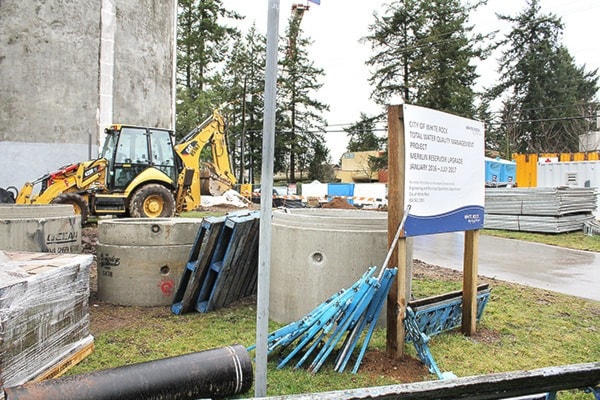The City of White Rock will not have any extra time to implement secondary disinfection of its water supply, after Fraser Health rejected the city’s request to extend the deadline beyond June 30, 2016.
The request came after a Jan. 11 meeting, during which council heard from Fraser Health officials about the need for secondary disinfection, as well as health and infrastructure effects of chloramine and chlorine use as treatment methods.
Council voted unanimously that evening to request an extension from Fraser Health for implementing a treatment plan and to use chlorine, not chloramine, after criticism from residents over potential negative health effects of the proposed treatment.
In a Jan. 18 letter from Fraser Health in Monday’s council agenda, environmental health officer Lloyd Struck said the city “did not provide any valid reasons to postpone” disinfection, which Fraser Health directed the city to undertake after a 2010 boil-water advisory.
“The equipment is already in place to provide chlorine for most of the wells,” Struck writes. “We are not aware of the city having any operational or procedural problems with meeting the June deadline.”
During Struck’s Jan. 11 visit to council, he and Dr. Michelle Murti, Fraser Health’s medical health officer, said the city had been lucky not to have had contamination problems prior to 2010, describing the water system as an “aging infrastructure.”
Mayor Wayne Baldwin later told Peace Arch News the comments were “a little over the top” and described the infrastructure as “in better shape than it ever was.”
On Tuesday, Murti acknowledged the system has undergone “a lot of improvements” since the Total Water Quality Management Project began in 2013, under the utility’s then-owner Epcor.
“A lot good work has already been done and certainly continues to happen as part of the Total Water Quality Management plan,” Murti told PAN.
“Even if you had a brand new system, it’s a large system with reservoirs and a lot of piping in terms of distributing water through a large area. All of that infrastructure always has the potential for leaking, for breakdown, for other points of entry for microbial contamination.”
Monday, city manager Dan Bottrill pointed to the $12-million “sizable investment” being spent – between Epcor and the city – on upgrading the system, including replacement of the Merklin high reservoir.
He acknowledged the 2010 E. coli scare – which was attributed to bird droppings entering the Merklin high reservoir through a breached roof seal – was an indication of “how sensitive any water utility is” to contamination.
“I’m not so sure it’s the infrastructure itself,” Bottrill said. “There’s a lot of work to be done to ensure proper processes are in place so that your system is tight and things that shouldn’t be getting into the system are kept out.”
Bottrill said that while it’s “positive” to see such public interest in the management of the water utility, the disinfection debate has, until recently, overshadowed the high arsenic and manganese levels in the water.
“Quite frankly, it’s a good thing that people have a greater awareness of water-quality issues,” Bottrill said. “There has been a lot of discussion about chlorine or chloramine. The real issue is arsenic and manganese.”
Test results from November show manganese levels in two wells (6 and 7) above the ‘esthetic objective’ target, with arsenic levels nearing the maximum allowable concentration as determined by Health Canada.
A treatment plan to reduce arsenic and manganese levels – yet to be approved by council – would take two to three years to implement, according to staff.
Murti told PAN arsenic and manganese are naturally occurring in groundwater sources and do not pose an “acute” threat, like a microbial contamination.
“(Arsenic) has been at this level for a number of years,” Murti said, noting the maximum allowable concentration is 10 micrograms per litre. “It’s not something we’re seeing significantly go up or down.”
Murti said that long-term exposure to arsenic can increase a person’s risk for cancer – particularly liver and lung – and that Fraser Health’s mandate is for the levels to be “as low as reasonably achievable.”
“If you were to drop arsenic levels to five or three, there would be a reduced risk of lifetime cancer in the population,” she said.
Price ‘still not there’
Nearly three months have passed since White Rock took ownership and operation of the water utility, but the city is still no closer to negotiating a purchase price with Epcor, Bottrill told PAN.
Though the Aug. 28 purchase agreement – available in a redacted version on the city’s website – set a target date of Jan. 18, 2016 for the start of arbitration should the parties be unable to negotiate a price, Bottrill said there are no plans in place for the process to get underway.
“We’re still not there,” he said.
